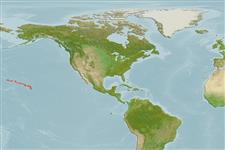Environment: milieu / climate zone / depth range / distribution range
Ökologie
seewasser riff-verbunden; standorttreu; tiefenbereich 5 - 138 m (Ref. 58302), usually 10 - ? m (Ref. 9710). Tropical; 30°N - 17°N
Eastern Central Pacific: Johnston (Ref. 11013) and Hawaiian Islands.
Size / Gewicht / Alter
Maturity: Lm ? range ? - ? cm
Max length : 12.5 cm TL Männchen/unbestimmt; (Ref. 30504)
Bright orange with irregular, close-set, thin, vertical black stripes on body, head, and fins; the dorsal, caudal, and anal fins with bright blue margin; the pectoral and pelvic fins orange to bright yellow.
Inhabit rock, coral, or rubble areas of seaward reefs; juveniles occasionally in 5 m (Ref. 9710). Benthopelagic (Ref. 58302). Feed on algae and detritus (Ref. 13550). Oviparous (Ref. 240), monogamous (Ref. 52884). Peak reproductive activity occurs from mid-December through May. Spawn at dusk during the week before full moon (Ref. 4858).
Life cycle and mating behavior
Geschlechtsreife | Fortpflanzung | Ablaichen | Eier | Fecundity | Larven
Pelagic spawner. Distinct pairing (Ref. 240). Monogamous mating is observed as both facultative and social (Ref. 52884).
Allen, G.R., 1985. Butterfly and angelfishes of the world. Vol. 2. 3rd edit. in English. Mergus Publishers, Melle, Germany. (Ref. 4858)
IUCN Rote Liste Status (Ref. 130435)
Bedrohung für Menschen
Harmless
Nutzung durch Menschen
Aquarium: Kommerziell
Mehr Information
ReferenzenAquakulturAquakultur ProfilZuchtlinienGenetikElectrophoresesVererbbarkeitKrankheitenVerarbeitungNutrientsMass conversion
Tools
Zusatzinformationen
Download XML
Internet Quellen
Estimates based on models
Preferred temperature (Ref.
123201): 8.8 - 25.5, mean 20.2 °C (based on 6 cells).
Phylogenetic diversity index (Ref.
82804): PD
50 = 0.5000 [Uniqueness, from 0.5 = low to 2.0 = high].
Bayesian length-weight: a=0.03090 (0.01359 - 0.07026), b=2.89 (2.70 - 3.08), in cm total length, based on LWR estimates for this (Sub)family-body shape (Ref.
93245).
Trophic level (Ref.
69278): 2.6 ±0.26 se; based on food items.
Widerstandsfähigkeit (Ref.
120179): mittel, Verdopplung der Population dauert 1,4 - 4,4 Jahre. (Preliminary K or Fecundity.).
Fishing Vulnerability (Ref.
59153): Low vulnerability (10 of 100).
Nutrients (Ref.
124155): Calcium = 103 [48, 158] mg/100g; Iron = 0.724 [0.443, 1.224] mg/100g; Protein = 18 [17, 19] %; Omega3 = 0.133 [0.078, 0.219] g/100g; Selenium = 31.6 [16.3, 60.2] μg/100g; VitaminA = 97.9 [25.2, 367.3] μg/100g; Zinc = 1.76 [1.19, 2.55] mg/100g (wet weight);
